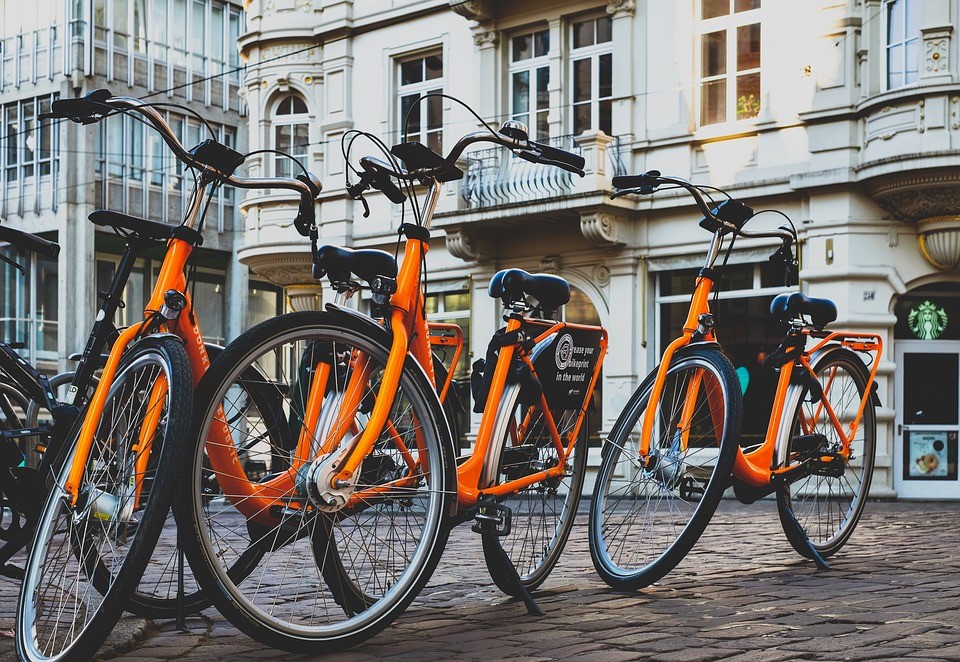- Mon-Fri 9am-4pm EST
- 888-663-4621
With the ongoing environmental problems that our planet is facing, it’s no surprise that there is an increase in the number of organizations devoting their time and efforts into coming up with plans that can later reduce the harmful environmental effects caused by various corporations.
Over the past few years, there has been an evident increase in cycling among communities across the nation. The Better Bike Share is a partnership funded by the JPB Foundation. It aims to build equitable and replicable bike share systems that will benefit everyone in the community as well as that of corporations and businesses.
In this guide, you’ll learn everything there is to know about cycling and the increasing demand for bike racks. Moreover, it is important to address this issue because cycling may be one of the many steps we should take to ensure a sustainable future.

Getting to Know the Bicycle as a Form of Transit
A number of transit agencies are now devoting their resources into advancing the bicycle industry. As a result, the idea of “Bike Share” has been going around various communities as a means to increase freedom and mobility. With this, people can get to places more easily without any harsh environmental or economic effects.
This concept of sharing bikes can be beneficial for people of all incomes, class, race, and demographics. Furthermore, it seems that it also has the capability to resolve another issue faced by communities today – the lack of engagement in the members of our society.
Moreover, whether or not people are sharing bicycles or are bringing their own, agencies should be able to integrate bicycles into everyday transit. This may have been quite a success over the years due to the fact that there are certain noticeable changes in today's transportation landscape.
One thing you should know is that bicycle is often used to cover a distance from one to three miles; this is typically beyond walkable distance but can be accessed despite not having a vehicle.
There are a number of municipalities across North America that are aiming to develop a number of strategies that will assist in the facilitation of cycling as a mode of transportation. All of these are made possible as soon as they start implementing a number of bike-friendly policies and establishing on-street facilities.
To realize that cycling is a mode of transportation and that this presents opportunities for active transportation is a critical aspect that will allow the government to further develop the economy as a whole; this already includes customer mobility and public health.
The Importance of Integrating Bikes and Transit
By prioritizing bicycle routes to various transit stops as well as stations, local councils will be able to not only reduce traffic but also improve the experience of transit customers. In addition, achieving this goal may also increase the level of engagement of the members of the community.
Truly, the integration of bicycle and transit strategies are based on the dynamic needs of every individual in the community.
With that in mind, here are some of the benefits of bicycle integration:
• One of the more obvious facts of bicycle integration is its low environmental impact. It can greatly become very advantageous for the personal and public health of everyone in the community.
• By creating commercial bike racks as a means to support its integration into the transit system of the community, there is the creation of more established and more convenient connections to fixed-route transit service.
• People are much more engaged as compared to when they were locked up in their private vehicles. Nonetheless, the success of this bicycle integration project will pave the way to an expanded reach of transit.
• This bicycle integration also helps with the creation of goodwill with customers as well as other members of society.
• Businesses will find that supporting the integration of the use of bicycle into the community’s transit system, such as establishing commercial bike racks near offices, can help manage the demand for car parking for your employees and customers.
• Lastly, this bicycle integration can potentially reduce drive-alone trips, especially when it is in use as a particular tool in the Transportation Demand Management Programs.

What are the Goals and their Respective Strategies for Engaging Community
In a report released by the Better Bike Share Partnership, they had identified three goals for increasing the level of engagement of a community through bike integration.
Increasing everyone’s access to mobility
The first goal it increases access to mobility. To achieve this, strategies like reducing the financial and physical barriers to use should be implemented.
With the first goal, some of the actions necessary to be performed to realize the success of this project are as follows – financial barriers reduction can pertain to discounted membership options, easy cash access, a number of flexible payment options, and a combined Bike Share and Transit Passes.
Moreover, physical barriers can be reduced by establishing commercial bike racks, walkable distances between drop-off points and stations, the improvement of community planning processes, and building better bike lanes.

Getting more people to use the bicycle
The second goal is to get more people to use the bicycle, whether it is to go to work, go to school, or simply go around the city. The strategies to be implemented for this particular goal includes the creation of opportunities for in-person interaction as well as proper teaching and empowerment of both the new and existing riders.
You can ensure the second goal’s success by introducing Bike Share, and other projects that promote the use of a bicycle, to a number of community events. Furthermore, on-the-ground engagement teams play an important role in achieving this goal.
Other examples or actions necessary to fulfill the second goal includes the following – learn-to-ride classes provided for everyone in the community, a number of community rides, and an adaptive bike programming. As you may have noticed, almost all of these examples bring about a sense of engagement from every individual in the community.
Increasing everyone’s awareness and support for Bike Share
The third and last goal identified by the Better Bike Share Partnership is to increase awareness as well as support for Bike Share. Here, there is a need to implement strategies concerning the proper building of necessary partnerships with various local organizations and the creation of multi-faced marketing campaigns.
As for the third goal, this is achievable if the members of the community start investing in mutually beneficial programming, job pipelines, inclusive multi-lingual ads and outlets, and of course, incentives to ride.
Why Businesses are Becoming More Bike-Friendly
Now, ever since the Bike Share partnership program, people are more inclined to support businesses that are more eco-friendly. Furthermore, there are also a number of indirect advantages to becoming a more bike-friendly business.
In today’s world, there are so many bike advocates that it has truly impacted each and every industry. Most of the time, in cities as well as dense urban environments, businesses and companies tend to oppose changes to streets that would improve walking as well as biking access and safety; this is for the reason that these changes require the loss of parking space.
For most business owners, parking spaces are what attracts their customers to go to their shops. With the fear of losing parking space comes the fear of losing customers. This is indeed an understandable assumption. You may have had your fair share of experiences where you go somewhere that has better parking.
However, The Conversation has recently released the findings of a particular study concerning a restaurant in Brisbane, Australia. It was a surprise for almost everyone to see that there was an increase in the number of daily customers this restaurant receives when they started to promote commercial bike racks near their business.
Looking and studying at the data, the researchers realized that the restaurant, as most business owners around the world, have overestimated by more than a double the actual importance of their customers who typically come by car.
Of course, every city is different and this study from Brisbane still presents a number of holes. However, as consumers become more and more educated about the environmental and economic effects of their actions, there is a high chance that their modes of transportation may evolve.
On another note, there are also certain businesses that would want to focus on improving their business rather than investing in a bike rack for their customers and employees. For them, it’s all about the numbers and how much the business is making on a daily basis.
To combat this worry, there have also been a number of studies that show how the establishment of bike racks and the promotion of bike lanes cannot hurt the business. Instead, it presents facts that those businesses situated beside biking-improved streets and those near established commercialized bike racks are earning a higher level of revenue as compared to businesses who focus on customers that own and use a car.
In the end, business owners will have the last call. They have every right to decide whether or not it is best for their businesses to stay in their current track of placing importance on customers that own and use a car – or if there is a growing need to refocus on getting commercialized bike racks and improving bike lanes.
What Cities That Are Growing Their Bicycling Communities Have To Say
According to Bicycle Parking Program Manager Nathan Broom of the Association of Pedestrian and Bicycle Professionals, there is a shred of strong indicative evidence that the number of people who are getting around by bicycle is increasing. As a result, businesses are responding to this trend by providing them with bike racks.
There is a rising need to target bike riders
There are a number of cities that have promoted bike racks and lane throughout their streets. In response to the rising trend of the use of bicycles, businesses who are looking for ways to target bike riders are now investing in bike racks in exchange for parking spaces for actual cars.
Businesses with their own bike racks are succeeding
Those who are growing their bicycling communities share how there is an increasing demand for businesses to have their own bike parking area or commercialized bike racks. For one, this is needed because it has the ability to attract more customers, which is what most businesses aim for.
Bike racks as a marketing campaign
On another note, becoming a bike-friendly business can actually function as a marketing campaign; this talks about a bike-friendly brand positioning. This is deemed as a favorable trend that can please the majority of consumers.
Fostering engagement within the community
Bicycling communities can also foster engagement within the community. Moreover, there are a number of cities around the globe that are using alternative modes of transportation, such as bikes. With that in mind, it seems that various businesses and local councils have a huge impact on a community’s level of engagement.
Final Thoughts on the Relationship between Bike Racks and the Community
In the end, the support that most people provide for those who are willing to make a change is incredible. There are a number of benefits for members of the community as well as business owners. For one, the environmental impact of this change can drastically increase the odds in our favor for a more sustainable future.
As for the community’s level of engagement, people are becoming more involved with what the local councils and their neighbors as up to as compared to when they are cooped up in their own world.
Lastly, businesses should be able to respond to the rising trend of how people are directed toward the use of bicycles rather than cars. If they want to keep up with the competition, they should invest in a bike parking space for their businesses.
A wall of bike racks only requires a small area; yet, it can already accommodate a number of employees and customers. As compared to very big vehicles, the promotion of bike racks in certain businesses can actually help them cut back on cost in the long run. Furthermore, by investing in adequate bike parking space or bike racks, businesses can ensure that these are not in the way of passersby and pedestrians.
You must login to post comments.